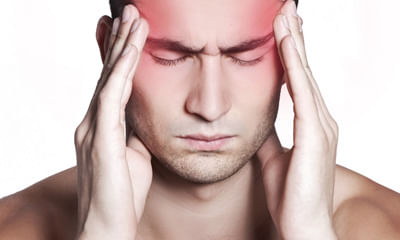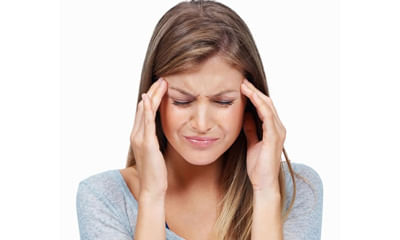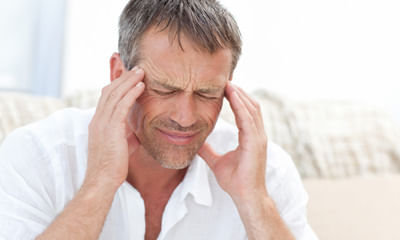Pounding Headache On Left Side Of Head
Doctor, My left side head just above the left eyes is paining hard from last one week. ...
Ask Free Question
Hi, There are many different types of headaches. Although not all headaches are the same, they all share at least one thing in common -- they cause pain. But many headaches also cause other unwanted symptoms. Migraines and other types of headaches, such as tension headache and sinus headache, are painful. Migraine symptoms include a pounding one sided headache, nausea, vomiting, and light sensitivity and are treated with antinausea drugs and abortive or preventive medications. Hypertension is also one of the important causes. Headache remedies include pain relievers like analgesics and antipyretics.
Hello doctor sum times I do badly suffer due to headache. It's not happen daily or weekly it happens rarely but whenever ...
Ask Free Question
Hi, There are many different types of headaches. Although not all headaches are the same, they all share at least one thing in common -- they cause pain. But many headaches also cause other unwanted symptoms. Migraines and other types of headaches, such as tension headache and sinus headache, are painful. Migraine symptoms include a pounding one sided headache, nausea, vomiting, and light sensitivity and are treated with antinausea drugs and abortive or preventive medications. Hypertension is also one of the important causes. Headache remedies include pain relievers like analgesics and antipyretics. Stress Management May Ease Your Headache Cope better with stress in your life, and you’ll help your headaches. Relaxation Techniques for Headache Relief These exercises will help you relax during stressful times. Headache relief is in sight. For you it could be migraine. A video consultation is recommended.
I had cause a blunt blow on my left eyes n nose then I got treatment at aiims Delhi my eyes r ok but since then I am hav ...
Ask Free Question
Hi, There are many different types of headaches. Although not all headaches are the same, they all share at least one thing in common -- they cause pain. But many headaches also cause other unwanted symptoms. Migraines and other types of headaches, such as tension headache and sinus headache, are painful. Migraine symptoms include a pounding one sided headache, nausea, vomiting, and light sensitivity and are treated with antinausea drugs and abortive or preventive medications. Hypertension is also one of the important causes. Headache remedies include pain relievers like analgesics and antipyretics. A video consultation is recommended Care Stress Management May Ease Your Headache Cope better with stress in your life, and you’ll help your headaches. Relaxation Techniques for Headache Relief These exercises will help you relax during stressful times. Headache relief is in sight. A video consultation is recommended with ct scan report of head if any.
I am suffering from migraine from past 5 years I am taking pills every day regularly but still the intensity of the pain ...
Ask Free Question
Hello Mr. Lybrate user Migraine headache is the worst kind of chronic headache. Migraine headache can be defined as severe pounding or pulsing headache that generally starts in the forehead and moves usually towards one side of the head (left side or right side headache) and around the eyes. Migraines, most of the times, attack with warnings or painful symptoms including nausea, vertigo, facial flushing, nasal congestion and dizziness. Acc to Ayurveda this condition is referred as ‘Sooryavarta’. Soorya means ‘Sun’ and avarta means ‘affliction’ or ‘blockage’. The headache gets worsened on sunrise, peaks during noon hours and reduces after evening. Even though this is the typical feature of this illness, it may not be true in all cases. Symptoms may vary based on body prakriti and food habits. Causes acc yo Ayurveda Suppression of natural urges Indigestion Intake of stale food Prolonged exposure to sunlight Oily and spicy food Anger, jealousy, grief, stress etc Intake of dry, pungent and salty food etc Alcohol or smoking Changes in hormone levels during a woman’s menstrual cycle or with the use of birth control pills Changes in sleep patterns – excess sleep or less sleep Exercise or other physical stress Excessive stimulation or stress on sense organs by loud noises, bright lights, strong perfumes / odours, Fasting Stress and anxiety Symptoms Moderate to severe, throbbing headache- right side or left side of the head. Head pain that gets severe with increased physical activity. Sensitivity to light and/or sound. Nausea or vomiting. Red eyes with burning sensation in eyes Loss of appetite Migraine sufferer wants to stay all alone and finds comfort in silent and dark room Depression and irritability Numbness or weakness in an arm or leg. Tips: Do not take pain killers frequently, over intake may cause rebound headache Sleep and eat on time Atleast 7 hours of sleep at night is effective. Avoid fasting. It will increase both Pitta and Vata dosha, worsening migraines. Do not skip meals. Avoid deodorant / perfume Quit smoking and alcohol. Do not use a/c for long period of time. Avoid green chilli use. You can have cinnamon, cardamom, clove, ginger and pepper. Observe for those things or foods that trigger a migraine attack, try to avoid them. Tie a tight cloth around the head to decrease blood flow to the scalp and lessen the throbbing and pounding of migraine headache. Remedies Decoction of jeera and ginger 20 ml twice a day. Raisins and almonds soak over night have in empty stomach. Pomegranate and grape juice. Carrot intake is good during attack. Apply cinnamon powder with warm water on temple and forehead. Steam inhalation with mint leaves. Rx Pathyadi kadha 10 ml_0_10 ml diluting with warm water b/f Niargim tab 1_0_1 a/f gor 3 weeks.
Hi, I am 25 year, male. I have these headaches, sometimes to extreme that I need to sleep to get rid of it. I am sensiti ...
Ask Free Question
According to symptoms you you're narrating it is migraine headache for more details go through the article below and if willing can consult me A migraine headache is a primary headache disorder that affects approximately 12% of the population. It is a headache that tends to recur in an individual and is moderate to severe if left untreated. It can be one sided, throbbing and aggravated by routine physical activity. It can be associated with light and sound and even smell sensitivity and many patients will become nauseated with it.. In a minority of patients there can be visual or sensory changes before, during or after the headache, known as auras. What Causes a Migraine The exact causes of migraines are unknown, although they are related to changes in the brain as well as to genetic causes. People with migraines may inherit the tendency to be affected by certain migraine triggers, such as fatigue, bright lights, weather changes and others. For many years, scientists believed that migraines were linked to the expanding (dilation) and constriction (narrowing) of blood vessels on the brain?s surface. However, it is now believed that migraine is caused by inherited abnormalities in certain areas of the brain. There is a migraine "pain center" or generator in the mid-brain area. A migraine begins when hyperactive nerve cells send out impulses to the blood vessels leading to the dilation of these vessels and the release of prostaglandins, serotonin and other inflammatory substances that cause the pulsation to be painful. Certain brain cells that use serotonin as a messenger are involved in controlling mood, attention, sleep, and pain. Therefore, chronic changes in serotonin can lead to anxiety, panic disorder, and depression. What Triggers a Migraine Many migraines seem to be triggered by external factors. Migraine sufferers can help the physician identify these triggers. Possible triggers include: Emotional stress is one of the most common triggers of migraine headache. Migraine sufferers generally are highly affected by stressful events. During stressful events, certain chemicals in the brain are released to combat the situation . The release of these chemicals can provoke migraine. Repressed emotions surrounding stress, such as anxiety, worry, excitement and fatigue can increase muscle tension and dilated blood vessels can intensify the severity of migraine. Sensitivity to specific chemicals and preservatives in foods. Certain foods and beverages, such as aged cheese, alcoholic beverages, and food additives such as nitrates and monosodium glutamate may be responsible for triggering up to 30% of migraines. Caffeine. Excessive caffeine consumption or withdrawal from caffeine can cause headaches when the caffeine level abruptly drops. The blood vessels seem to become sensitized to caffeine, and when caffeine is not ingested, a headache may occur. Caffeine itself is often helpful in treating acute migraine attacks. Changing weather conditions such as storm fronts, barometric pressure changes, strong winds or changes in altitude Menstrual periods Tension Excessive fatigue Missing meals Changes in normal sleep pattern Are migraines hereditary? Yes, migraines have a tendency to run in families. Four out of 5 migraine sufferers have a family history of migraines. If one parent has a history of migraines, the child has a 50% chance of developing migraines, and if both parents have a history of migraines, the risk jumps to 75%. What are the symptoms of migraines? The symptoms of migraine headaches can occur in various combinations and include: Type of pain The pain of a migraine can be described as a pounding or throbbing. The headache often begins as a dull ache and develops into throbbing pain. The pain is usually aggravated by physical activity. Severity/intensity of pain The pain of a migraine can be described as mild, moderate, or severe. Untreated the headache will become moderate to severe Location of pain The pain can shift from one side of the head to the other, or it can affect the front of the head or feel like it?s affecting the whole head. Duration of pain Most migraines last about 4 hours, although severe ones can last up to a week. Frequency of headaches The frequency of migraines varies widely among individuals. It is common for a migraine sufferer to get 2-4 headaches per month. Some people, however, may get headaches every few days, while others only get a migraine once or twice a year. Associated symptoms Sensitivity to light, noise and odors Nausea and vomiting, stomach upset, abdominal pain Loss of appetite Sensations of being very warm or cold Paleness Fatigue Dizziness Blurred vision Diarrhea Migraine with aura Migraine without aura "Aura" is a physiological warning sign that a migraine is about to begin. What are the symptoms of migraines with aura? Migraines with auras occur in about 15-20% of migraine sufferers. An aura can occur before, during, or after the pain occurs and last from 15 to 60 minutes. The symptoms always last less than one hour. Visual auras include: Bright flashing dots or lights Blind spots Distorted vision Temporary vision loss Wavy or jagged lines There are also auras that can affect the other senses. These auras can be described simply as having a "funny feeling," or the person may not be able to describe the aura. Other auras may include ringing in the ears (tinnitus), or having changes in smell (such as strange odors), taste, or touch. Retinal migraine: temporary, partial or complete loss of vision in one eye, along with a dull ache behind the eye that may spread to the rest of the head. Basilar artery migraine: dizziness, confusion or loss of balance can precede the headache. The headache pain may affect the back of the head. These symptoms usually occur suddenly and can be associated with the inability to speak properly, ringing in the ears, and vomiting. This type of migraine is strongly related to hormonal changes and primarily affects young adult women. Status migrainosus: a rare and severe type of migraine that can last 72 hours or longer. The pain and nausea are so intense that people who have this type of headache often need to be hospitalized. Certain medications, or medication withdrawal, can cause this type migraine syndrome. Ophthalmoplegic migraine: pain around the eye, including paralysis in the muscles surrounding the eye. This is an emergency medical condition, as the symptoms can also be caused by pressure on the nerves behind the eye or an aneurysm. Other symptoms of ophthalmoplegic migraines include droopy eyelid, double vision, or other vision changes. What are the symptoms of migraines without aura Migraines without auras are more common, occurring in 80 to 85 percent of migraine sufferers. Several hours before the onset of the headache, the person can experience vague symptoms, including: Anxiety Depression Fatigue or tiredness How are migraines treated? Many medications are available to treat migraines. Homeopathy Management Homeopathy has always cured so many cases of migraine I have my personal experience in curing migraine so nicely with homeopathy In other systems they called it incurable but in homeopathy its curable.Migraine is one of the diseases for which homeopathy can positively do something. Here there is another special significance. In Allopathic medicine there is no remedy for this disease. So it is common to find patients coming for homeopathy treatment after suffering for 10 to 15 years, despite allopathic treatment. And Homeopathy does wonders for the migraine, where patient has no other option. For chronic & acute conditions patient needs constitutional treatment to reduce the recurrence of attacks and pain here few therapeutic index i had taken from Nash which really helped me lot in acute condition,but remember its constitutional which works well .



